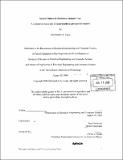| dc.contributor.advisor | Peter Szolovits. | en_US |
| dc.contributor.author | Cassa, Christopher A | en_US |
| dc.contributor.other | Massachusetts Institute of Technology. Dept. of Electrical Engineering and Computer Science. | en_US |
| dc.date.accessioned | 2006-06-19T17:43:19Z | |
| dc.date.available | 2006-06-19T17:43:19Z | |
| dc.date.copyright | 2004 | en_US |
| dc.date.issued | 2004 | en_US |
| dc.identifier.uri | http://hdl.handle.net/1721.1/33124 | |
| dc.description | Thesis (M. Eng. and S.B.)--Massachusetts Institute of Technology, Dept. of Electrical Engineering and Computer Science, 2004. | en_US |
| dc.description | Includes bibliographical references (leaves 55-57). | en_US |
| dc.description.abstract | Syndromic surveillance systems, especially software systems, have emerged as the leading outbreak detection mechanisms. Early outbreak detection systems can assist with medical and logistic decision support. One important concern for effectively testing these systems in practice is the scarcity of authentic outbreak health data. Because of this shortage, creating suitable geotemporal test clusters for surveillance algorithm validation is essential. Described is an automated tool that creates artificial patient clusters by varying a large variety of realistic outbreak parameters. The cluster creation tool is an open-source program that accepts a set of outbreak parameters and creates artificial geospatial patient data for a single cluster or a series of similar clusters. This helps automate the process of rigorous testing and validation of outbreak detection algorithms. Using the cluster generator, single patient clusters and series of patient clusters were created - as files and series of files containing patient longitude and latitude coordinates. These clusters were then tested and validated using a publicly-available GIS visualization program. All generated clusters were properly created within the ranges that were entered as parameters at program execution. Sample semi-synthetic datasets from the cluster creation tool were then used to validate a popular spatial outbreak detection algorithm, the M-Statistic. | en_US |
| dc.description.statementofresponsibility | by Christopher A. Casa. | en_US |
| dc.format.extent | 57 leaves | en_US |
| dc.format.extent | 3462820 bytes | |
| dc.format.extent | 3464026 bytes | |
| dc.format.mimetype | application/pdf | |
| dc.format.mimetype | application/pdf | |
| dc.language.iso | eng | en_US |
| dc.publisher | Massachusetts Institute of Technology | en_US |
| dc.rights | M.I.T. theses are protected by copyright. They may be viewed from this source for any purpose, but reproduction or distribution in any format is prohibited without written permission. See provided URL for inquiries about permission. | en_US |
| dc.rights.uri | http://dspace.mit.edu/handle/1721.1/7582 | |
| dc.subject | Electrical Engineering and Computer Science. | en_US |
| dc.title | Spatial outbreak detection analysis tool : a system to create sets of semi-synthetic geo-spatial clusters | en_US |
| dc.type | Thesis | en_US |
| dc.description.degree | M.Eng.and S.B. | en_US |
| dc.contributor.department | Massachusetts Institute of Technology. Department of Electrical Engineering and Computer Science | |
| dc.identifier.oclc | 62240853 | en_US |
